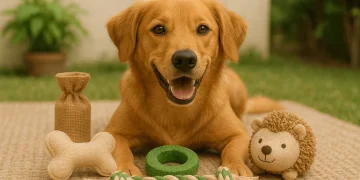Training your pet to respond to basic commands is not just about impressing friends or showing off your pet’s abilities—it’s essential for their safety and well-being. Whether you have a puppy, kitten, or an adult dog or cat, teaching basic commands can improve communication, reduce behavioral issues, and ensure your pet’s safety. Basic commands like “sit,” “stay,” and “come” are essential skills that help keep your pet safe in various situations, manage their behavior, and strengthen the bond between you and your furry companion.
In this guide, we will explore how to teach your pet these essential commands, the benefits of each command, and tips to ensure the process is positive and effective. Whether you are new to pet training or are simply looking for better ways to teach your pet these basics, this article will provide you with all the tools you need to get started.
Why Basic Commands Matter
Before diving into the step-by-step process of teaching your pet the essential commands, it’s important to understand why these skills are so crucial. Basic commands help in the following ways:
- Safety: Commands like “stay” and “come” can keep your pet safe in dangerous situations. For example, if your dog runs into traffic, a quick “come” can save their life.
- Control: Teaching your pet basic commands gives you better control over their behavior, both indoors and outdoors. It reduces unwanted behaviors and helps prevent accidents.
- Bonding: Training is a great way to strengthen the bond between you and your pet. Positive reinforcement techniques, such as rewards and praise, create a rewarding relationship built on trust and respect.
- Socialization: Basic commands are also important for socializing your pet with other people and animals. Well-behaved pets are generally better received in social settings, whether at the park, in the home, or at the vet.
- Mental Stimulation: Training your pet’s brain helps keep them mentally stimulated. Pets that are mentally engaged tend to be less anxious and more well-behaved.
The Importance of Positive Reinforcement
Positive reinforcement is one of the most effective methods of training pets. This technique involves rewarding your pet for performing the desired behavior, reinforcing the connection between the behavior and the reward. The rewards could include treats, praise, toys, or even a favorite activity, depending on your pet’s preferences.
Positive reinforcement works because it encourages pets to repeat the behavior that earns them rewards. It also makes training sessions enjoyable, which helps to maintain their interest and motivation. Avoid punishment-based training, as it can lead to fear, confusion, and damaged trust between you and your pet.
1. Teaching “Sit”: The Foundation of Training
The “sit” command is one of the first and easiest commands to teach your pet. It serves as the foundation for many other behaviors and is an essential command in many situations. A dog or cat that knows how to sit on command is much easier to control in everyday life, whether you’re trying to get their attention, calm them down, or avoid dangerous situations.
Steps to Teach “Sit”
- Get Your Pet’s Attention: Hold a treat in your hand to get your pet’s attention. Ensure they focus on the treat.
- Position the Treat: Slowly move the treat above your pet’s nose and then back toward their ears. As your pet follows the treat with their eyes, their bottom should naturally lower to the ground.
- Say the Command: Once their bottom touches the ground, say the word “sit” clearly and firmly.
- Reward Immediately: As soon as they sit, immediately praise them and give them the treat. This immediate reinforcement helps them connect the action to the reward.
- Repeat: Practice the “sit” command several times during each training session. Short, frequent sessions are more effective than long, infrequent ones.
Troubleshooting Tips
- If they jump: Some pets, especially puppies, may try to jump for the treat. If this happens, try holding the treat closer to their nose and gently guiding them into a sitting position.
- Patience is key: If your pet doesn’t get it right away, don’t get frustrated. Keep practicing, and always reward progress, even if it’s small.
2. Teaching “Stay”: Teaching Patience and Self-Control
Once your pet has mastered the “sit” command, it’s time to move on to the “stay” command. Teaching your pet to stay is particularly important for safety—if your dog or cat gets excited and runs off, the “stay” command can prevent dangerous situations. It’s also a helpful command for controlling behavior in social settings.
Steps to Teach “Stay”
- Start with a Sit: Begin with your pet in the sitting position. This is important because the “stay” command is usually easier for pets to learn if they’re already in a stable position.
- Show the Hand Signal: Hold your hand out in front of your pet, palm facing them. This hand signal, combined with the verbal “stay” command, will reinforce the message.
- Say the Command: While your pet is sitting, calmly say the word “stay” in a firm, clear voice.
- Take a Step Back: Slowly take a step back while keeping your hand out. If your pet stays in place, immediately praise and reward them. If they move, gently guide them back to the sitting position and repeat the command.
- Gradually Increase Distance and Duration: Over time, increase the distance you move away from your pet and the length of time they stay. Be patient and gradually build up their ability to stay longer and farther from you.
Troubleshooting Tips
- If they get up too early: If your pet breaks the stay too soon, calmly return them to the sitting position and try again. Don’t reward them for breaking the stay. They’ll quickly learn to remain in position until given the release cue.
- Start small: Start by only taking one step back and slowly increasing the distance. If you take too many steps or extend the time too quickly, your pet may become confused or frustrated.

3. Teaching “Come”: The Life-Saving Recall Command
The “come” command, often called the recall command, is one of the most important commands you can teach your pet. This command ensures that your pet will return to you when called, whether in an emergency or simply when you need their attention. It is especially important for outdoor activities like walking, hiking, and playing in an unfenced area.
Steps to Teach “Come”
- Start with Short Distances: Begin indoors or in a quiet, enclosed area. Start by calling your pet’s name in a cheerful, inviting tone. Follow it with the word “come.”
- Use Treats or Toys: Hold a treat or favorite toy in your hand and encourage your pet to come toward you. When they do, praise them enthusiastically and offer the reward.
- Repeat and Reward: Practice calling your pet from short distances. Gradually increase the distance between you and your pet as they learn to respond to the “come” command.
- Use Positive Reinforcement: Always reward your pet immediately after they come to you. Positive reinforcement is key to ensuring your pet continues to respond positively to the command.
- Gradually Add Distractions: Once your pet has mastered “come” indoors, try practicing outside with mild distractions, such as other pets or people. Always reward your pet for responding correctly.
Troubleshooting Tips
- If they ignore you: If your pet doesn’t come when called, don’t chase them. Instead, use a more exciting tone of voice or entice them with a toy or treat. Never punish them for not responding—this could cause them to associate the command with negative experiences.
- Practice in different environments: To ensure reliability, practice the “come” command in various environments, including places with distractions such as parks or backyards.
4. General Training Tips for Success
Training your pet to master essential commands can be a fun and rewarding experience. To ensure success, here are a few tips to keep in mind:
Consistency is Key
Consistency is vital for pet training. Use the same verbal commands and hand signals every time you train your pet. This helps your pet understand exactly what behavior you are expecting and makes learning easier.
Keep Training Sessions Short and Positive
Training sessions should be short, no longer than 5-10 minutes. Pets, especially puppies and kittens, have short attention spans, so it’s important to keep sessions fun and engaging. End each session on a positive note, rewarding your pet for their progress.
Patience and Persistence
Training takes time, especially when teaching more complex commands. Be patient with your pet and remember that every pet learns at their own pace. Avoid getting frustrated, as this can negatively impact your pet’s enthusiasm for learning.
Socialization and Distraction Training
Once your pet has mastered basic commands in a calm environment, begin to introduce distractions and practice in new settings. This helps your pet learn to respond to commands even when there are other people, animals, or noises around.
Conclusion
Teaching your pet essential commands like “sit,” “stay,” and “come” not only improves their behavior and communication but also enhances their safety and your relationship with them. By using positive reinforcement, patience, and consistency, you can help your pet master these commands and enjoy a lifetime of better understanding and cooperation. Remember, training is an ongoing process, and the more you invest in your pet’s education, the stronger your bond will be. Happy training!























































